Visiting Masterpieces of Architecture in the Art Capital
2021/4/2
Barcelona (Spain)
Barcelona, the second largest city of Spain, is filled with passion and colour, and is also home to some of the world’s most famous architecture. In the latter half of the 19th century, Barcelona experienced the Industrial Revolution early on, and an artistic and cultural movement called “Modernisme” was born. This was not just a pursuit of the new, but also a search for the unique identity of Catalonia, where Barcelona is located. Let’s see with our own eyes the “dreamscape” that Gaudi and other unusual creative architects pursued. In this fascinating city, illuminated by the dry Mediterranean sunshine, let’s visit six Modernisme buildings that are also World Heritage sites.
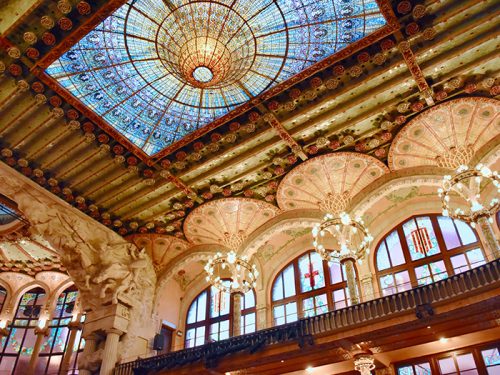
Architect of Flowers, Montaner
After being welcomed by the statue of Columbus in the plaza near the port, we walk down the crowded pedestrian street La Rambla to the old town with its stately streets. On the corner, you will see a gorgeous building. It is the Palau de la Música Catalana, a concert hall and masterpiece by Montaner, who played a significant role in the Modernisme movement. Steel was used for the framework, the latest building material at the time, and the exterior walls are decorated with a variety of floral tiles and sculptures. Most impressive is the interior. The chandeliers adorning the main hall, surrounded by stained glass, are so beautiful and elegant that they leave you speechless. The passion of Modernisme has already gripped our heart.
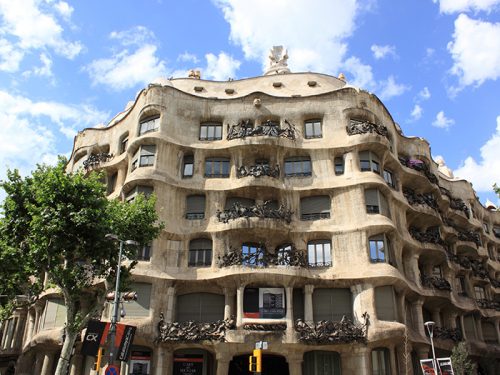
Gaudi’s Mansion, Full of Innovation
Lined on the Passeig de Gracia, the centre of Modernisme, is the Casa Batlló, redesigned by Antoni Gaudí. The ultra-colored glass mosaics, skeletal balconies, and scales on the roofs stir the imagination of all who see them. Casa Milà, also by Gaudi, is a five-minute walk from here, and is said to be “architecture that expresses life” with its motif of nature. Both buildings are characterized by their curvilinear beauty, with details such as doors and staircases, as well as courtyards to let in natural light, in pursuit of innovation and livability.

The Sagrada Familia, the Unfinished World Heritage Site
As soon as you step up to the surface from the subway station, your eyes are immediately drawn to the towering Sagrada Familia. We finally meet! The anticipation and excitement runs through the body when you finally see it. Its construction began in 1882, and Gaudi became its second architect at the young age of 31. He considered the entire building to be a “Bible in stone,” and the World Heritage Site’s Nativity Façade is a meticulously carved representation of the birth of Christ. Because it is yet unfinished, the stone cathedral has an atmosphere of almost being alive. You can look up at the whole view, gaze at the detailed sculptures, and enjoy Gaudi’s endless worldview to your heart’s content.
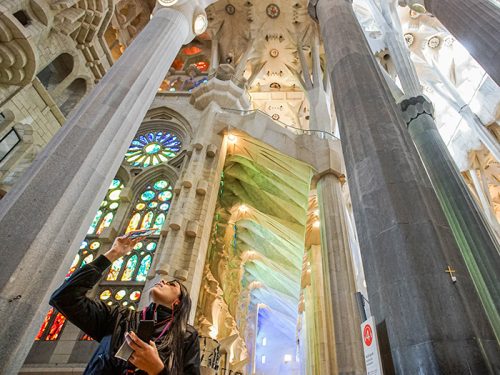
From the Nativity façade with its bronze ivy leaves, we enter the cathedral. there, a space unimaginable from the exterior unfolds. Tree-like white pillars branch out to the ceiling, and the light that pours down is like sunlight filtering through the trees. On the east side of the basilica are stained glass windows of cooler colors, and on the west side are similar windows of warmer colors, changing the color of the church according to the inclination of the sun. In fact, the structure of the basilica is so meticulously thought out that you can feel a different impression of Gaudí’s image as “eccentric.” The main altar, the bell tower, and the spiral staircase like a conch shell are just a few of the highlights that will make you lose track of time.
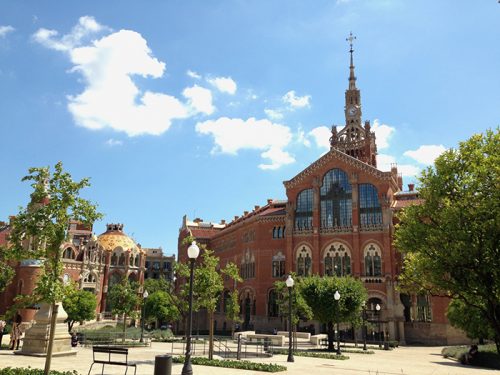
The World’s Most Beautiful Hospital
Although we not want to leave, we glance back at the Sagrada Familia as we then walk along the Avinguda Gaudí, extending to the north. The colorful buildings in front of us are the Hospital de Sant Pau. From the decorative tiles and flowers in the stained glass, you can see that this is the work of Montaner. At first glance, the hospital looks gorgeous, but the pink and light, regular colors that remind us of life give us a calming impression. The building was also very functional, with underground passages connecting the buildings. Montaner’s belief that “art has the power to heal people” has continued to be celebrated with grace over time.
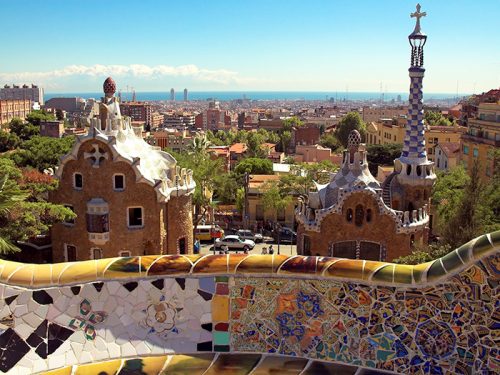
Traces of Gaudi’s Dreams
On top of a hill overlooking the city is Parc Güell, a remnant of the rural residential area that Gaudi promoted at the request of his investor, Mr. Güell. The park is decorated with trencadís, a technique of laying colorful fractured tiles, which is a characteristic of Modernisme architecture. The smoothly curved benches made from pieces of discarded pottery are ergonomically designed. Rubbing my neck, a little sore from looking up at the buildings so much, you can sit down on a bench and gaze out at the city in the dusk. Throughout this day we truly experienced the passion of Modernisme firsthand. The traces of the dreams left behind by architects who expressed the joy of living continue to colour this city.
PHOTO: PEACEBOAT, Kataoka Kazushi, Okuhira Keita, Yuruki Shiho
